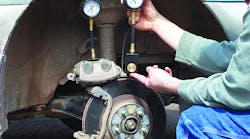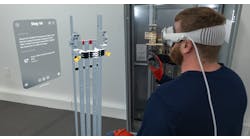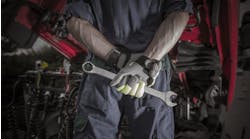If a customer comes to you with uneven brake wear and you just assume it is a bad caliper and replace it, you may be guessing. Imploded brake hoses and stuck proportioning valves produce hidden symptoms that are not easily diagnosed.
Symptoms of an imploded brake hose occur when the inner nitrile tube of the brake hose ruptures. Using vice grips to crimp off a brake hose when changing calipers is a bad practice since, many times, it will break the inner nitrile tube, setting the stage for a hose rupture and implosion. Some manufacturers clamp the brake hose to the fender wall. Over time, there is a warring effect between the point where the hose is held tight in the clamp and where it flexes. Over time, the inner tube will rupture again, setting the stage for an implosion of the inner tube.
Once the tube rupture occurs and the brakes are applied, the brake fluid is pushed past the rupture, actuating the caliper. However, when you release the brake, the implosion acts like a one-way valve, not allowing the fluid to find its way back to the master cylinder or the caliper to release. This has all the indications of a stuck slide or frozen piston, but it is only the hose that needs replacement. It is a hard lesson to learn when the car comes back with the same symptoms after replacing all the brake hardware, (i.e., rotor calipers and brakes).
Uneven brake wear can also be misdiagnosed very easily because there are no tools to detect its hidden cause. Here is a very common scenario that shop owners face because of uneven brake wear: A customer comes in with one side brake pads worn down to the metal and the other side in good shape. The first reaction is to replace the calipers, rotors and brakes. Then test drive the car and return it to the customer. Two weeks later, the customer comes back and describes the same noise and problem as before, but this time, they’re not so nice! As soon as you pull the car into the shop and hear the metal scraping again, you will immediately know what the problem is, but may not know why it’s happening again. At this point, some techs will install a second set of parts, hoping the first caliper was bad; maybe replace the proportioning valve, the master cylinder, or the brake hose.
IPA’s Disc Brake System Analyzer is designed to save the day. It can accurately detect exactly where the problem is and allow the tech to fix it the first time, saving time, energy, guesswork and embarrassment when the customer comes back. It can quickly identify an imploded brake hose and efficiently diagnose a proportioning valve imbalance.
Information provided by:Innovative Products of America (IPA)



